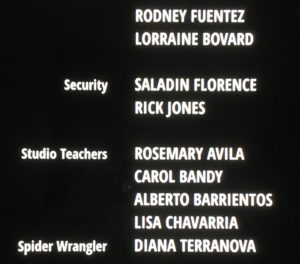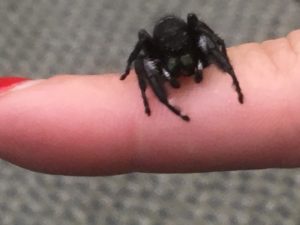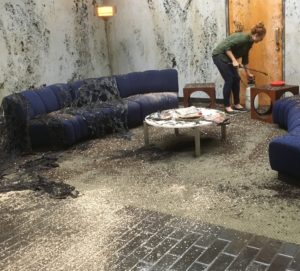 We concluded our previous post with reference to King Kong’s lost spider scene — a sequence so horrifying that producer-director Merian C. Cooper insisted that it be removed from the final cut. His reasoning: “It stopped the show.”
We concluded our previous post with reference to King Kong’s lost spider scene — a sequence so horrifying that producer-director Merian C. Cooper insisted that it be removed from the final cut. His reasoning: “It stopped the show.”
A victim of judicious editing, that scene now joins other lost segments of film history, such as the pie fight deleted from Doctor Strangelove and the jitterbug number edited out of The Wizard of Oz — removed because they detracted from the central story.
And now we have one more item to add to the list of lost scenes: the “Egress” spider from Nightmare Cinema.
Above: David Slade’s sketch of the spider from the deleted opening of “This Way to Egress.”

Dedicated credit readers (of which there were many at the Parkway Theater last Saturday) may note the inclusion of a spider wrangler in the film’s final credits, a listing that might seem to refer to Nightmare Cinema’s first segment: Alejandro Bruges’s “The Things in the Woods.” There are certainly plenty of spiders in that episode. Thousands of them. But all are either CGI effects or sculpted props. Nothing to wrangle there. So why a spider wrangler?
Here’s the story.

Although the script for “This Way to Egress” closely follows the arc of “Traumatic Descent” (the story on which the film is based), a number of scenes were added during the final rewrite. The most substantial of them, inserted into the middle of the story, extend the protagonist’s exploration of a labyrinthian office building. Retained in the final cut, those scenes support the story’s progressive decline from everyday reality to surreal nightmare.
By contrast, the spider scene was intended to serve as a kind of preview — a visual overture for the nightmare to come.
Two versions of the spider scene were considered before filming began. One, which is depicted in David Slade’s storyboard at left, opens with the shot of a web clinging to a ceiling. Moving closer, we see a spider perched within the web. Closer still, we see the spider’s fangs and staring eyes as it peers down at a doctor’s waiting room. A second version of the scene, this one included in the shooting script, opens with the close-up of the spider’s face then rotates until we find ourselves looking over the spider’s humped back and down through its web. Far below, seemingly caught within the web, a woman and two children sit in a waiting room.

Either way, the spider sequence would have provided foreshadowing for the monsters of “This Way to Egress” and a callback to the eight-legged invaders 0f Alejandro Burges’s “The Thing in the Woods.” But unlike the bugs in “The Woods,” the spider in the scene from “Egress” was real, which called for a wrangler — Diana Terranova.
A trained entomologist and member of the Animal Handlers Union, Diana arrived on the “Egress” set with a collection of plastic boxes. Inside each, sometimes perched on a piece of twig, a bug awaited its audition. First up, a whip scorpion.
 Though neither a true scorpion nor a spider, the whip scorpion (above right) might have fit the bill were it not for the size of its fangs. David wanted them to be huge.
Though neither a true scorpion nor a spider, the whip scorpion (above right) might have fit the bill were it not for the size of its fangs. David wanted them to be huge.
Next came a tarantula (left), whose fangs were considerably larger but nonetheless dwarfed by the size of its body. Back in the box!

Ironically, the role went to the smallest of the lot (right), a tiny black speck the size of a fingertip but with fangs that bore a striking resemblance to David’s initial sketch. Shot in extreme closeup, those mouthparts would appear walrus size.
The spider scene was filmed by a second-unit team working in a corner of the “Egress” set, a conventional office space that had been transformed into a mold-and-grit covered nightmare by production designer Lauren Fitzsimmons.

To work her magic, Lauren and her crew spent hours applying fine, black grit to the floor, walls, ceiling, and furniture of the set. Resembling black mold, the grit looked like the stuff you might find if you opened a broken refrigerator that had been left closed for a year. Little bits of black grit everywhere!
The second unit work was going well until the spider, evidently energized by the lights, decided to bolt and hide among the grit. A search ensued, the spider was found, and the scene was shot without further incident.
 But then, weeks later, David and his editor Tony Kearns (who also worked on Black Mirror‘s “Bandersnatch” and “Metalhead”) reviewed the footage and decided not to use it. As David explains, “It was such a powerful, startling image that it stole from the first scene.” Or, in the words of Merian C. Cooper, it “stopped the show.”
But then, weeks later, David and his editor Tony Kearns (who also worked on Black Mirror‘s “Bandersnatch” and “Metalhead”) reviewed the footage and decided not to use it. As David explains, “It was such a powerful, startling image that it stole from the first scene.” Or, in the words of Merian C. Cooper, it “stopped the show.”
Nightmare Cinema was released to theaters on June 21 and is currently available via video on demand from iTunes, Amazon, FandangoNow. DVD and Blu-Ray editions are scheduled for release on September 3. As I write this, it continues its run at select theaters, including The Parkway Theater in Pittsburgh where you still have time to catch it as it was intended to be seen — on the big screen before a roomful of responsive fans.
Images:
Spider sketch, storyboard, and spider screenshot copyright © 2019 by David Slade.

Leave a Reply